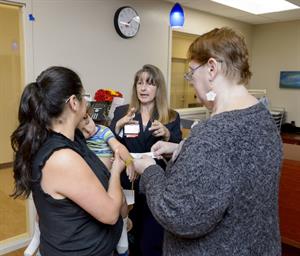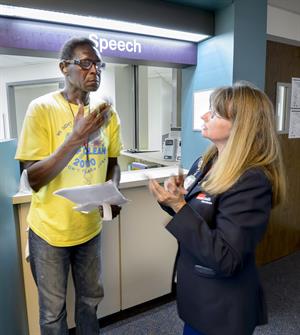 Eileen Schubert, a certified American Sign Language interpreter at UTMB, makes the sign for “interpreter.” Schubert connects the deaf and hearing worlds, bridging communication gaps between medical staff and patients or caregivers who are hearing impaired.
Eileen Schubert, a certified American Sign Language interpreter at UTMB, makes the sign for “interpreter.” Schubert connects the deaf and hearing worlds, bridging communication gaps between medical staff and patients or caregivers who are hearing impaired.
Eileen Schubert’s fingers rapidly flip and bend as she uses her hands to explain a doctor’s instructions to a patient.
As a certified American Sign Language interpreter at UTMB, Schubert connects the deaf and hearing worlds, bridging communication gaps between medical staff and patients or caregivers who are hearing impaired.
“When I was told I could talk all day long for a career, I knew this was the job for me,” says Schubert with a smile, who started learning sign language at age 29 after taking part in a deaf play for community theater. “I started taking classes and it evolved into a college degree. If I had realized how hard it was to learn sign language then, I probably wouldn’t have done it. But in this case, ignorance is bliss (laughs).”

I join Schubert early on a Tuesday morning in the Day Surgery waiting room at Jennie Sealy Hospital on the Galveston Campus. A young boy is scheduled for a tonsillectomy and his deaf mother needs the help of an interpreter as nurses and doctors prep for surgery.
Wearing her signature navy blue Patient Services jacket, Schubert interprets simultaneously between spoken and sign language for more than an hour, making sure the mother gets answers to all of her questions and understands the surgery plan.
“It’s a big responsibility,” says Schubert. “I have to understand exactly what the doctor is saying to accurately explain to the patient or their caregiver. Sometimes, I’ll stop the doctor and say ‘Are you saying take two pills in the morning and two pills at night or are you saying take two pills altogether?’ It’s so important to make it clear for the patient because their health and well-being depend on it.”
Schubert has been at UTMB for nearly a year, since her position was made possible through the 1115 Healthcare Transformation waiver. She travels everywhere UTMB has a hospital or clinic to provide interpretation services for patients—from UTMB’s three campuses to Regional Maternal and Child Health clinics in Conroe, Beaumont and Pearland—and averages more than 30 scheduled appointments a month.
“Sign language brings together people of all races, ethnicities and religious backgrounds because they all share a common language—deaf culture knows no boundaries,” says Schubert. “I love interacting with patients and being exposed to various sign-language accents. For example, I helped an older man from Galveston the other day who used very distinctive southern signs. Then, I worked with a deaf teenager who used more slang. Just like with English, words evolve or are used in a different way, so I’m constantly learning.”

My attention shifts back to the young boy as he is wheeled off to the OR. Schubert gets the mother settled in the waiting area and shows her how to track her son’s patient number on the TV monitors. Schubert will be back to help interpret post-surgery, but in the meantime, she is needed for a post-partum appointment at the Primary Care Pavilion across the street. Schubert is familiar with the patient—she interpreted throughout the woman’s labor and delivery a few weeks ago.
“That was a hectic day,” says Schubert. “I had been in Angleton with another patient and got a call that I needed to get to Galveston ASAP for a woman in labor. Once I got here, I stood for the entire birth, interpreting everything the doctor said. During the ‘push’ phase, I was telling her to take deep breaths and push while counting at the same time. I was even holding my breath, too, and doing everything with her, so she could watch my face for guidance. At the same time, I tried to stay out of the way of the doctors and nurses. Right after the baby was born, I was called to interpret at Hospital Galveston (UTMB-TDCJ Hospital) for a critical patient who was having some heart issues. It was nonstop!”

As we walk into the PCP, Schubert’s face lights up as she spots the new mother she helped through labor. The two immediately start signing about how the first few weeks of motherhood have gone, and Schubert sits with her during the appointment. Besides providing the new parents with additional support and explanations, she also ensures that the doctor understands the unique needs of the baby and mother.
“Building ongoing relationships with patients is beneficial for everyone,” says Schubert. “I don’t just act as the voice of the doctor or the voice of the deaf person; I get invested in their long-term health plans and serve as an advocate. I learn how to read their body language and facial expressions and know when to ask a physician to explain something more so the patient can truly understand how to best have their medical needs met.”
Over the years, Schubert has become accustomed to being included in others’ intimate moments—such as the birth of a child or the last moments of a person’s life.
“There are emotional times when I have to stay professional and just focus on doing my job,” says Schubert.
After the PCP appointment, we walk back to Jennie Sealy to see how the young boy and his mother are doing. The boy is spending the night at the hospital, so Schubert will be back later to check on him. She heads to her office on the second floor to see if any additional appointments that day require an interpreter. Schubert is accustomed to last-minute requests, cancellations and changes in schedules.
 ASL Eileen Schubert166
ASL Eileen Schubert166
She checks the Epic electronic medical record several times a day for the latest appointment information and will use an outside vendor or Video Remote Interpretation technology if needed. VRI uses iPads to offer patients on-demand video language interpretation services with a live person on screen. The most common languages accessed at UTMB are Spanish and ASL, but a total of 12 video languages are available. If a patient requires a language not included in the program, a separate audio interpretation service is available in more than 200 languages.
There’s no need for VRI today, as Schubert has one final appointment in Audiology at the University Health Clinics. The patient has been having trouble with one of his hearing aids. Schubert works with his doctor to help clear up confusion about his insurance coverage and arrange a payment plan for the needed repair.

Once everything gets straightened out, the patient leaves with a smile on his face and Schubert leaves feeling reassured that she chose the right career—she was able to talk all day and make a difference in patient’s lives.
“I enjoy my job because it’s different every day—different clinics, different people, different reasons why they are here,” says Schubert. “What never changes is my goal to break down language barriers and make sure every patient receives the best care possible.”